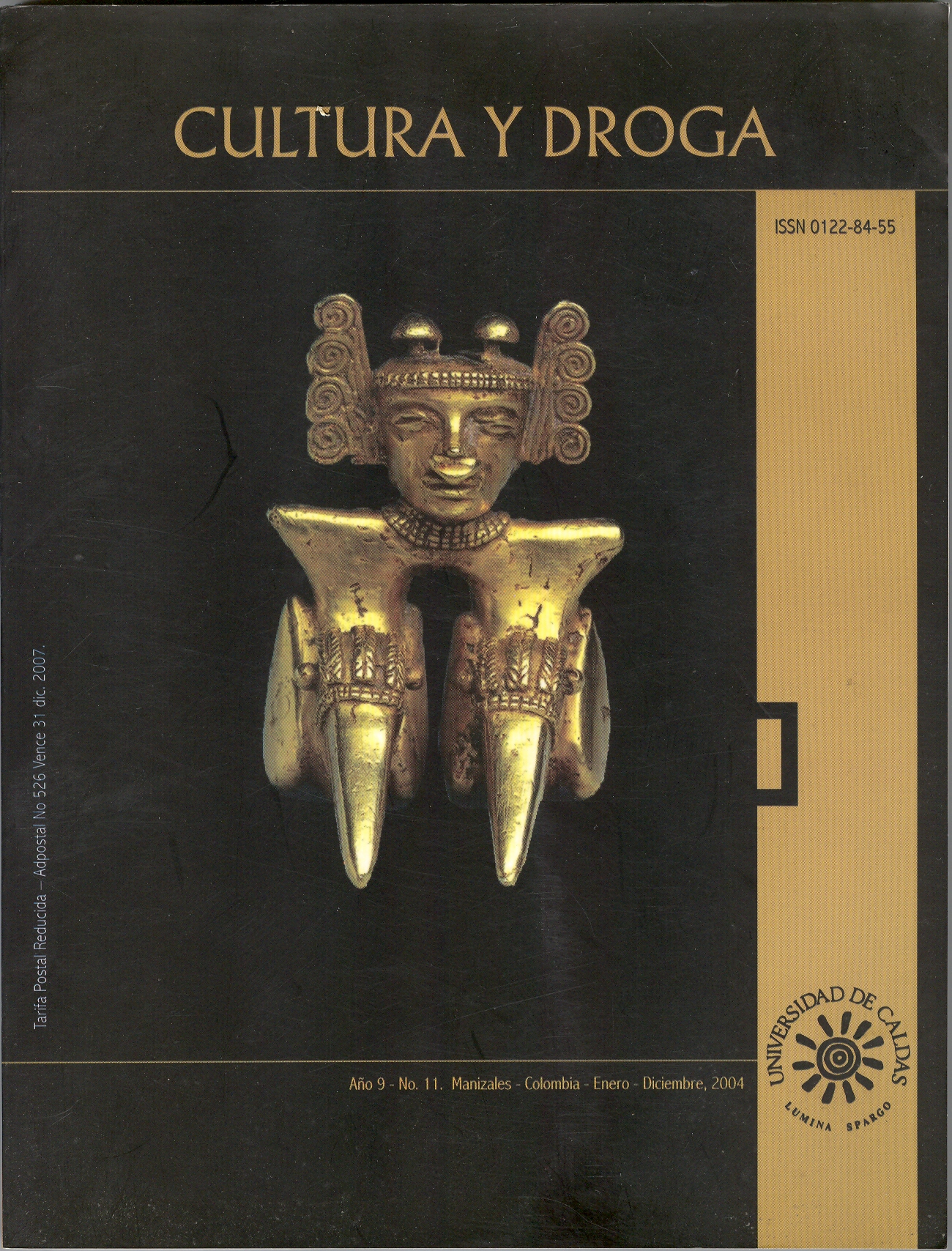Authors
Abstract
ABSTRACT:This work analyzes the evidence for the usage of visionary mushrooms in the Nor- thern Andes. It begins with an evaluation of the information referring to visionary plants in the pre-Hispanic epoch with particular emphasis on mushroom use. It con- tinues with a detailed study of Darien pendants; these objects provide the most sug- gestive evidence that proposes a ritual use of mushrooms during the pre-Colombian period. It is proposed that this shamanic tradition entered Colombia from Mesoame- rica as part of the exchange of technology and ideas ca. 100-500 d.C.
References
––––––, 1992. “Sitio Conte metalwork in its Pan-American context”. En River of Gold. Precolumbian Treasures from Sitio Conte, editado por Pamela Hearne and Robert J. Shearer, pp. 32-46, The University Museum of Archaeology and Anthro- pology, University of Pennsylvania, Filadelfia.
COOKE, Richard G. and Warwick BRAY, 1985. “The goldwork of Panama: An iconographic and chronological perspective”. En The Art of Precolumbian Gold. The Jan Mitchell Collection, editado por Julie Jones, pp. 34-45, Little, Brown and Company, Boston.
EMMERICH, André, 1965. Sweat of the sun and tears of the moon; gold and silver in pre-Columbian art. University of Washington Press, Seattle.
FALCHETTI, Ana María, 1979, “Colgantes ‘Darién.’ Relaciones entre areas orfe- bres del occidente Colombiano y Centroamerica”. Boletín 2: 1-55, Museo del Oro, Banco de la República, Bogotá, Colombia.
––––––, 2000. “The gold of Greater Zenú. Prehispanic metallurgy in the Caribbean lowlands of Colombia”. En Precolumbian Gold. Technology, Style and Iconography, editado por Colin McEwan, pp. 132-151, Fitzroy Dearborn Publishers, Chicago.
FERNÁNDEZ DISTEL, Alicia A., 1980. “Hallazgo de pipas en complejos pre- cerámicos del borde de la Puna Jujeña (Republica Argentina) y el empleo de alu- cinógenos por parte de las mismas culturas”. Estudios Arqueológicos 5: 55-75, Uni- versidad de Chile, Antofagasta.
FUNG, Rosa, 1972. “Las Aldas. Su ubicación dentro del proceso histórico del Perú antiguo”. Dédalo 9-10, Museu de Arte e Arqueología, Universidade de Saô Paulo, Brazil.
FURST, Peter T., 1974. “Hallucinogens in Precolumbian art”. En Art and environ- ment in native America, editado por Mary E. King y Idris R. Traylor, pp. 50-101, Museum of Texas Technological University, Lubbock, Texas.
HEIM, Roger, 1963. Les Champignons Toxiques et Hallucinogènes. N. Boubée & Cie., Paris.
HEIM, Roger and R. Gordon WASSON, 1958. “Les champignons hallucinogènes du Mexique”. Achives du Muséum National D’Histoire Naturelle, tome VI (Séptima serie), Editions du Museum, Paris.
LATHRAP, Donald, D. COLLIER, and H. CHANDRA, 1976. Ancient Ecuador: Culture, clay and creativity, 3000-300 B.C. Field Museum of Natural History, Chi- cago.
LLAGOSTERA, Agustín, Constantino M. TORRES and María A. COSTA, 1988. “El complejo psicotrópico en Solcor-3 (San Pedro de Atacama)”. Estudios Atacame- ños 9: 61-98, Instituto de Investigaciones Arqueológicas, Universidad del Norte, San Pedro de Atacama.
OTT, Jonathan, 1996. Pharmacotheon. Entheogenic Drugs, their Plant Sources and History, second ed. Natural Products Company, Kennewick, Washington.
PÉREZ DE BARRADAS, José, 1954. Orfebrería Prehispánica de Colombia: Estilo Calima, 2 vols. Museo del Oro, Banco de la República, Bogotá, Colombia.
––––––, 1966. Orfebrería Prehispánica de Colombia: Estilos Quimbaya y otros, 2 vols. Museo del Oro, Banco de la República, Bogotá, Colombia.
PLOWMAN, Timothy 1984. “The origin, evolution, and diffusion of Coca, Eryth- roxylum spp., in South and Central America”. En Pre-Columbian Plant Migration, editado por Doris Stone, pp. 125-163 (44th Congreso Internacional de Americanis- tas, Manchester, Inglaterra), Harvard Uiversity Press, Cambridge, Massachusetts.
REICHEL-DOLMATOFF, Gerardo, 1988. Goldwork and Shamanism. An icono- graphic study of the Gold Museum. Compañía Litográfica Nacional S.A., Medellín, Colombia.
PLAZAS, Clemencia, and Ana María FALCHETTI, 1979. “La orfebrería Prehis- pánica de Colombia”. Museo del Oro, Banco de la República, Bogotá.
SCHULTES, Richard Evans, and Alec BRIGHT, 1979. “Ancient gold pectorals from Colombia: Mushroom effigies?”. Botanical Museum Leaflets 27, 5-6: 113-141, Har- vard University
SCHULTES, Richard Evans, and Albert HOFMANN, 1980. The Botany and Che- mistry of Hallucinogens. Charles C. Thomas, Springfield, Illinois.
STAHL, Peter W., 1985. “The hallucinogenic basis of Early Valdivia Phase ceramic bowl iconography”. Journal of Psychoactive Drugs 17, 2: 105-123, San Francisco, California
STAMETS, Paul, 1996. Psilocybin Mushrooms of the World. An identification Gui- de. Ten Speed Press, Berkeley, California.
STOTHERT, Karen and Iván CRUZ CEVALLOS, 2001. “Making spiritual contact. Snuff tubes and other mortuary objecs from coastal Ecuador”. En Mortuary Practices and Ritual Associations. Shamanic Elements in Prehistoric Funerary Contexts in South America, Eitado por John E. Staller and Elizabeth Currie, pp. 51-56. BAR International Series 9982, Oxford.
TORRES, Constantino Manuel, 1981. “Evidence for snuffing in the prehispanic sto- ne sculpture of San Agustín, Colombia”. Journal of Psychoactive Drugs 13, 1: 53-60, San Francisco, California.
TORRES, Constantino M., David REPKE, Kelvin CHAN, Dennis MCKENNA, Agustín LLAGOSTERA, and Richard EVANS SCHULTES, 1991. “Snuff powders from Pre-Hispanic San Pedro de Atacama: Chemical and contextual analysis”. Cu- rrent Anthropology 32, 5: 640-649.
WASSÉN, S. Henry, 1967. “Anthropological survey of the use of South American snuffs”. En Ethnopharmacologic Search for Psychoactive Drugs, editado por Daniel H. Efron et al., 233-289, Public Health Service Publication 1645, U.S. Department of Health, Education, and Welfare, Washington, D.C.
––––––,1972. “A medicine-man’s implements and plants in a Tiahuanacoid tomb in highland Bolivia”. Etnologiska Studier 32: 7-114, Göteborgs Etnografiska Museum, Gotemburgo, Suecia.
WASSON, R. Gordon, 1980. The Wondrous Mushroom. Mycolatry in Mesoamerica. Ethnomycoloical Studies No. 7, McGraw-Hill Book Company, New York.
ZEIDLER, James, 1988. “Feline imagery, stone mortars, and Formative Period inte- raction spheres in the northern Andean area”. Journal of Latin American Lore 14(2): 243-283.

 PDF (Español)
PDF (Español)
 FLIP
FLIP

















